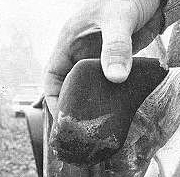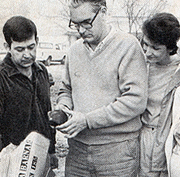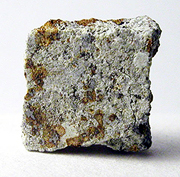Official Name:
Claxton is the name of the post office closest to where this meteorite fell.
Location:
About 10 kilometres southeast of Claxton, Georgia, USA.
Fall or Find:
Fall
Date:
10 December 1984, 5:30 p.m., local time.
Mass Recovered:
1 455 grams
Number of Fragments:
A single meteorite the size of a grapefruit was found. The form of the meteorite indicates that there may be other, undiscovered, fragments associated with it.
Crater:
When it was discovered, Claxton was lying in loose dirt at the bottom of a 30-centimetre deep hole.
Circumstances:
The fireball was seen by a witness in the town of Statesboro, 25 kilometres from Claxton. The colour of the fireball was yellow, it was about a quarter the size of the full Moon, and it lasted about 6 seconds. The observer noted no phenomenon of fragmentation.

Enlargement
Simulation of the moment of impact. The mailbox has been placed in its original position. |
|

Enlargement
Two meteorite researchers examining the impact site with the property owners. |
|
People a few dozen metres from the site of impact heard a whistling sound followed by a crash and a thud. The meteorite hit the mailbox of Mrs. Carutha Barnard before ending its race on the ground. The impact knocked the mailbox off its post.
History:
The objects that meteorites hit often become more famous than the meteorites themselves. This is the case of the Claxton meteorite, which is one of the most common types of meteorites.
Type:
Stony meteorite
Class:
Ordinary chondrite
Group:
L6

Enlargement
This slice of Claxton reveal its pale grey interior. Concentrations of metal are scattered throughout. The metal has rusted because of contact with the air. |
|
Composition:
Claxton is what is called an olivine-hypersthene chondrite: these two minerals make up most of its composition. A very thin (0.5 mm) black fusion crust covers the meteorite. The inside is light grey and shows large concentrations of magnetic metals.
The meteorite hit the mailbox with such force that the scientists found a little galvanized metal in the rock.
Scientific contribution:
The shape of the meteorite and the impact marks on the mailbox provided important information about the fall. Scientists were able to establish that the meteorite was oriented: it did not spin as it passed through the atmosphere. In addition, its fall was practically vertical at the end of its race.
Comments:
Meteorite collectors often receive their new acquisitions in the mail. The Claxton meteorite came special delivery-it's the only meteorite to land on a mailbox without someone sending away for it!
Part of the Planétarium's collection:
Yes